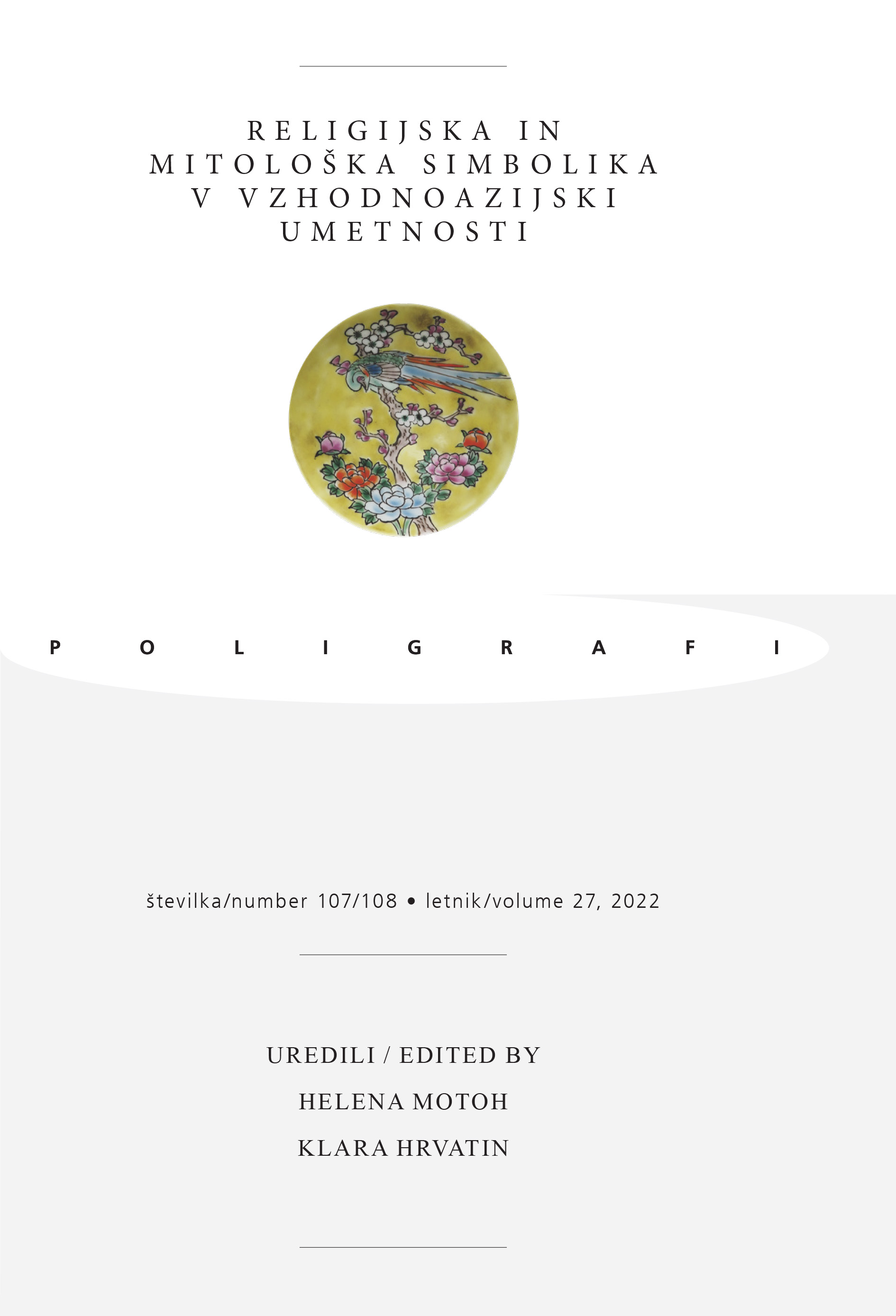Good-Luck “Beasts”
The Symbolism of Ornamental and Figurative Iconography on the Musical Instruments in the Skušek Collection
DOI:
https://doi.org/10.35469/poligrafi.2022.363Abstract
The musical instruments in the Skušek Collection of the Slovene Ethnographic Museum display ornamental and figurative depictions, the symbolism of which is in many ways challenging to interpret. Many of them refer to good-luck beasts or ruishou (瑞獸), the most prominent being the representations of the mythological beings of qilin (麒麟) and dragon long (龍), whose symbolism infiltrated Chinese history, folklore, religion and art very early on. In this paper we will primarily pursue two objectives: firstly, we will analyse the motifs of figurative depictions in the examined musical instruments to see if an interpretation of these motifs within a broader context of Chinese culture could yield new findings about musical instruments. Secondly, we will study the characteristics of symbolism on musical instruments in the framework of the five categories of symbolism on musical instruments as defined by the musicologist Gen’ichi Tsuge. As an illustration of the main points of the presentation, we will principally use the musical instruments and artwork from the collection of Ivan Skušek Jr., the largest collection of Chinese artefacts in Slovenia, which is preserved at the Slovene Ethnographic Museum.
References
“An exhibition of Chinese musical instruments and artefacts: musical continuity from antiquity to the present.” The music archive of Monash University, 20. september 2018. https://www.monash.edu/__data/assets/pdf_file/0003/2443809/2018d-Exhibition_Musical-Instruments-of-China-Catalogue.pdf.
Bates, Roy. All about Chinese Dragons. Peking: China History Press, 2007.
Chun-Sun Park, Jae-Im Kim. »Ch’ing Dragon Robes.« Journal of the Korean Society of Costume 50, št. 3 (2000): 59–72.
Durrant, Li, Stephen Durrant, in David Schaberg. Zuo tradition: Commentary on the Spring and Autumn Annals. Seattle in London: University of Washington Press, 2016.
Fandom. »Unicorn wiki: Qilin.« Dostop 28. novembra 2022. https://karkadann.fandom.com/wiki/Qilin.
Fang, Jing Pei. Symbols and rebuses in Chinese art: figures, bugs, beasts, and flowers. Berkeley, Toronto: Ten Speed Press, 2004.
Grame, Theodore C. »Sounding Statues: The Symbolism of Musical Instruments.« Expedition Magazine 16, št. 1 (Autumn 1973): 30–39.
Hrvatin, Klara. »Zbirateljska kultura in razstave vzhodnoazijskih glasbil na Slovenskem: identifikacija glasbil iz Skuškove zbirke.« Ars & Humanitas 14, št. 2 (2020): 119–35. https://doi.org/10.4312/ars.14.2.119-135.
Ip, Charlotte. »Chinese Mythology 101: Qilin (Kirin).« localiiz, 20. junij 2022. https://www.localiiz.com/post/culture-local-stories-chinese-mythology-101-qilin-kirin.
»Lute or pipa by Jin Shang.« Museum of Applied Science and Art. Dostopano 8. decembra 2022. https://collection.maas.museum/object/19347.
Montanič, Emanuela. »Kitajska tradicijska glasbila: komentiran prevod knjige Predstavitev kitajskih tradicijskih glasbil.« Diplomsko delo, Univerza v Ljubljani, 2013.
»Paperweight in the form of a Qilin.« The Metropolitan Museum of Art. Dostop 3. decembra 2022. https://www.metmuseum.org/art/collection/search/713154.
»Pipa.« The Metropolitan Museum of Art. Dostop 8. decembra 2022. https://www.metmuseum.org/art/collection/search/503651.
Qiang, Xi. Chinese music and musical instruments. Šanghaj: Shanghai Press, 2011.
»Qilin (Chinese mythology).« Encyclopædia Britannica. Dostop 28. novembra 2022. https://www.britannica.com/topic/qilin.
Robič, M. »Vera starih Slovanov v luči primerjajoče zgodovine verstva«, Popotnik XLVIII, št.8 (1927). Dostop 2. decembra 2022. http://staroverci.si/verastarih-slovanov-v-luci-primerjajoce-zgodovine-verstva/.
Somkina, Nadezhada. »Cultural hybridization: Nine Offspring of Chinese Dragon: The Origin and Cultural Impact.« International journal of Professional Science 1 (January 2022): 16–24.
Štrukelj, Pavla. »Kitajski dvorni moški kaftan.« Slovenski etnograf 18/19 (1965/66): 57–72.
»Teriomorfizam.« Hrvatska enciklopedija. Leksikografski zavod Miroslav Krleža, 2021. Dostop 2. decembra 2022. http://www.enciklopedija.hr/Natuknica. aspx?ID=60940.
Thrasher, Alan Robert. Chinese musical instruments. New York: Oxford University Press, 2000.
Tsuge, Gen’ichi. »Bamboo, Silk, Dragon and Phoenix: Symbolism in the Musical Instruments of Asia.« The World of Music 20, št. 3 (1978): 10–23.
Uchiyama, Jun’ichi. Auspicious animals: The art of good omens. Tokio: PIE International Inc., 2020.
Wang, Shengyu. »Cosmology, Fashion, and Good Fortune: Chinese Auspicious Ornament in the Han Dynasty (206 BC–AD 220).« Doktorska disertacija, University of Oxford, 2020.
Wang, Xuxiao. »Lucky Motifs in Chinese Folk Art: Interpreting Paper-Cut from Chinese Shaanxi.« Asian Studies 1, št. 2 (2013): 125–43. https://doi.org/10.4312/as.2013.1.2.125-143.
Watt, James C. Y. »The Giraffe As the Mythical Qilin in Chinese Art: A Painting and a Rank Badge in the Metropolitan Museum.« Metropolitan Museum Journal 43 (2008): 111–114.
Williams, C. Alfred Speed. Outlines of Chinese symbolism and art motives: an alphabetical compendium of antique legends and beliefs, as reflected in the manners and customs of the Chinese. New York: Dover Publications Inc., 1976.
Wilson, Samuel M. »The Emperor’s Giraffe.« Natural History 101, št. 12 (december 1992): 22–25.


